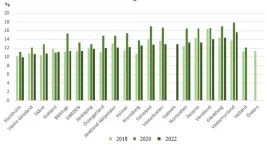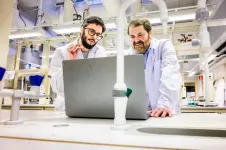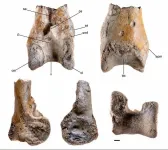(Press-News.org)
Stem cells grown in microgravity aboard the International Space Station (ISS) have unique qualities that could one day help accelerate new biotherapies and heal complex disease, two Mayo Clinic researchers say. The research analysis by Fay Abdul Ghani and Abba Zubair, M.D., Ph.D., published in NPJ Microgravity, finds microgravity can strengthen the regenerative potential of cells. Dr. Zubair is a laboratory medicine expert and medical director for the Center for Regenerative Biotherapeutics at Mayo Clinic in Florida. Abdul Ghani is a Mayo Clinic research technologist. Microgravity is weightlessness or near-zero gravity.
"Studying stem cells in space has uncovered cell mechanisms that would otherwise be undetected or unknown within the presence of normal gravity," says Dr. Zubair. "That discovery indicates a broader scientific value to this research, including potential clinical applications."
Dr. Zubair has launched stem cell experiments from his lab on three different missions to the ISS. His review paper provides data on the scientific question, "Is space the ideal environment for growing large numbers of stem cells?" Another key concern is whether cells grown in space could maintain their strength and function after splashdown on Earth.
"The goal of almost all space flight in which stem cells are studied is to enhance growth of large amounts of safe and high-quality clinical-grade stem cells with minimal cell differentiation," says Dr. Zubair. "Our hope is to study these space-grown cells to improve treatment for age-related conditions such as stroke, dementia, neurodegenerative diseases and cancer."
The challenges of growing stem cells on Earth
Adult stem cells found in bone marrow and adipose (fat) tissue do not divide and differentiate into specialized cells. As a result, the number of adult stem cells in any one patient is limited. To obtain enough stem cells for clinical research or patient use, cells must be multiplied and expanded. It's an expensive, time-consuming process with inconsistent results.
Through research on the International Space Station, scientists gained new understanding of how cells multiply, function and morph into specialized cells. Importantly, they've also discovered microgravity fosters better cell growth and function compared to those cultured in an Earth lab setting.
"The space environment offers an advantage to the growth of stem cells by providing a more natural three-dimensional state for their expansion, which closely resembles growth of cells in the human body. That's in comparison to the two-dimensional culture environment available on Earth that is less likely to imitate human tissue," says Dr. Zubair.
Discoveries from stem cells grown in space
The immediate value of the interstellar stem cell research may be in growing tissue for disease modeling. Space-cultured stem cells could be used to recreate lifelike models of cancer and other diseases in a petri dish. Researchers can then use these models to track disease progression and test new therapies to stop it.
A comprehensive review of papers from the Mayo Clinic and other academic health centers shows space research has applications well beyond the lab. Several stem cell lines grown in weightlessness have shown clinical potential:
Mesenchymal stem cells are adult stem cells that secrete growth factors with potential for healing. Dr. Zubair's team has documented that mesenchymal stem cells expanded in microgravity have greater immunosuppressant capabilities than those grown on Earth.
Hematopoietic stem cells have blood regenerative abilities to fight infection, stop bleeding and carry oxygen. Hematopoietic stem cells grown aboard the ISS have shown ability to expand and differentiate into red or white blood cells that could one day be used to manage patients with blood cancers.
Cardiovascular progenitor cells provide the building blocks for blood vessels and heart muscle. They play a crucial role in repairing muscle. Growing cardiovascular progenitor cells in space could someday provide new options for repairing tissue damaged by heart attack.
Neural stem cells are found in the central nervous system and play a key role in brain development, maintenance and repair. Neural cells expanded in a gravity-free environment and maintained their regenerative capabilities on Earth. Researchers are studying whether neural cells grown in space could offer replacement therapy for diseases of the central nervous system.
Hurdles to healing
Despite the promise of extraterrestrial stem cell research, researchers are faced with many challenges. Cells could lose their strength and ability to function after long-term exposure to microgravity. Over time, space radiation could damage DNA and affect the growth of cells. Another concern is whether cells grown in microgravity could turn cancerous. Dr. Zubair's team, however, found no evidence of chromosomal damage that could trigger cancer in mesenchymal stem cells cultured in space.
Stem cell research in the cosmos is in its early stages, and the full effects of multiplying cells in weightlessness are not fully understood. More scientific data, research and funding are needed to help researchers fully comprehend the clinical potential of space-expanded cells.
"The space research conducted so far is just a starting point. A broader perspective about stem cell applications is possible as research continues to explore the use of space to advance regenerative medicine," writes Dr. Zubair.
The National Aeronautics and Space Administration and Mayo Clinic's Center for Regenerative Biotherapeutics provided funding for this research. Revi
END
Space: A new frontier for exploring stem cell therapy
2024-11-04
ELSE PRESS RELEASES FROM THIS DATE:
History of concussion linked to higher risk of severe mental illness after childbirth
2024-11-04
Toronto, ON, November 4, 2024 – People with a history of concussion face a 25% higher risk of having severe mental health issues after childbirth, according to a new study from ICES and the University of Toronto.
The research underscores the importance of identifying individuals with past concussions early in their prenatal care and highlights the need for long-term, trauma-informed support to safeguard their mental health.
“We found that individuals with a history of concussion were significantly more likely to experience serious mental health challenges, ...
Combining two simple tools could combat election misinformation
2024-11-04
ITHACA, N.Y. – A popular new strategy for combatting misinformation doesn’t by itself help people distinguish truth from falsehood but improves when paired with reminders to focus on accuracy, finds new Cornell University-led research supported by Google.
Psychological inoculation, a form of “prebunking” intended to help people identify and refute false or misleading information, uses short videos in place of ads to highlight manipulative techniques common to misinformation, such as emotional language, false dichotomies and scapegoating. The strategy has already been deployed ...
Nanoscale transistors could enable more efficient electronics
2024-11-04
CAMBRIDGE, MA – Silicon transistors, which are used to amplify and switch signals, are a critical component in most electronic devices, from smartphones to automobiles. But silicon semiconductor technology is held back by a fundamental physical limit that prevents transistors from operating below a certain voltage.
This limit, known as “Boltzmann tyranny,” hinders the energy efficiency of computers and other electronics, especially with the rapid development of artificial intelligence technologies that demand faster computation.
In an effort to overcome this fundamental limit of silicon, MIT researchers fabricated a different type ...
UChicago scientist develops paradigm to predict behavior of atmospheric rivers
2024-11-04
When torrential rains and powerful winds hit densely populated coastal regions, whole cities can be destroyed—but governments and residents can take precautions with sufficient warning.
Many of these coastal deluges are caused by atmospheric rivers—regions of concentrated water vapor carried along on strong winds, sometimes called “rivers in the sky.” Meteorologists monitor them, but the ability to predict exactly how an atmospheric river might behave based on its underlying physics would offer more precise forecasts.
In a paper published today in Nature Communications, senior author Da Yang, assistant professor of geophysical sciences at the University ...
Childhood overweight is associated with socio-economic vulnerability
2024-11-04
More children have overweight in regions with high rates of single parenthood, low education levels, low income and high child poverty. The pandemic may also have reinforced this trend. This is shown by a study conducted by researchers at Uppsala University and Region Sörmland in collaboration with Region Skåne.
“During and after the pandemic, we see a greater difference between regions in terms of children's weight. It even looks like it has exacerbated health inequalities,” explains ...
Study reveals links between many pesticides and prostate cancer
2024-11-04
Researchers have identified 22 pesticides consistently associated with the incidence of prostate cancer in the United States, with four of the pesticides also linked with prostate cancer mortality. The findings are published by Wiley online in CANCER, a peer-reviewed journal of the American Cancer Society.
To assess county-level associations of 295 pesticides with prostate cancer across counties in the United States, investigators conducted an environment-wide association study, using a lag period between exposure and prostate cancer incidence of 10–18 years to account for the slow-growing nature of most prostate cancers. The years 1997–2001 ...
LiU researchers make AlphaFold predict very large proteins
2024-11-04
The AI tool AlphaFold has been improved so that it can now predict the shape of very large and complex protein structures. Linköping University researchers have also succeeded in integrating experimental data into the tool. The results, published in Nature Communications, are a step toward more efficient development of new proteins for, among other things, medical drugs.
In all living organisms, there is a huge variety of proteins that regulate cell functions. Basically, everything that happens in the body, from controlling muscles and forming hair to transporting ...
Fossil of huge terror bird offers new information about wildlife in South America 12 million years ago
2024-11-04
**EMBARGOED UNTIL RELEASE MONDAY, NOV. 4, AT 1 A.M. ET**
Researchers including a Johns Hopkins University evolutionary biologist report they have analyzed a fossil of an extinct giant meat-eating bird — which they say could be the largest known member of its kind — providing new information about animal life in northern South America millions of years ago.
The evidence lies in the leg bone of the terror bird described in new paper published Nov. 4 in Palaeontology. The study was led by Federico J. Degrange, a terror bird ...
Scientists create a world-first 3D cell model to help develop treatments for devastating lip injuries
2024-11-04
We use our lips to talk, eat, drink, and breathe; they signal our emotions, health, and aesthetic beauty. It takes a complex structure to perform so many roles, so lip problems can be hard to repair effectively. Basic research is essential to improving these treatments, but until now, models using lip cells — which perform differently to other skin cells — have not been available. In a new study published in Frontiers in Cell and Developmental Biology, scientists report the successful immortalization of donated lip cells, ...
One-third of patients with cancer visit EDs in months before diagnosis
2024-11-04
About 1 in 3 patients diagnosed with cancer in Ontario visited an emergency department (ED) in the 90 days before diagnosis, found a new study published in CMAJ (Canadian Medical Association Journal) https://www.cmaj.ca/lookup/doi/10.1503/cmaj.240952.
In a study that included more than 650 000 patients diagnosed with cancer between 2014 and 2021 in Ontario, 35% (229 683) had visited an ED in the 90 days before diagnosis. Among patients with ED visits before their cancer diagnosis, 64% had visited once, 23% had visited twice and 13% had 3 or more visits. ...


